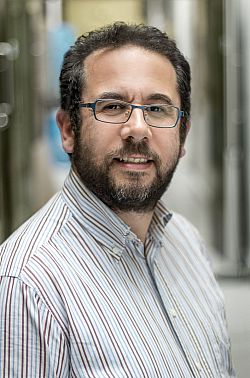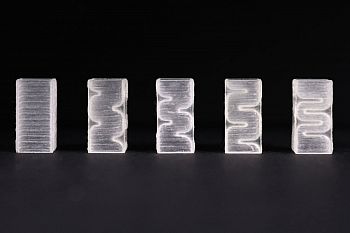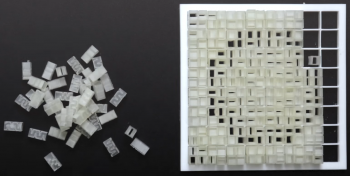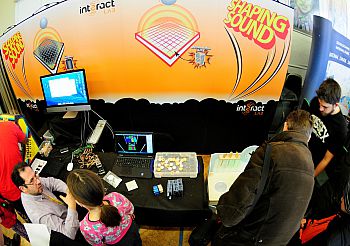Spotlight on Dr Gianluca Memoli
Research Fellow in Human-computer Interaction for Acoustic Levitation
Previous research
 My PhD focused on bubbles in space. Bubbles always go upwards on Earth…but this is not true in space. Whether they are used to cool your spaceship or are in the stomach of astronauts, causing them to burp like Barney in The Simpsons, bubbles in space need to be moved. My project was focused on creating an artificial gravity. To test our solution, we carried out tests whilst flying in micro gravity on the Zero-G aircraft (a.k.a. the vomit comet) and dropped our kit down a 10km coal mine. It was an incredible time.
My PhD focused on bubbles in space. Bubbles always go upwards on Earth…but this is not true in space. Whether they are used to cool your spaceship or are in the stomach of astronauts, causing them to burp like Barney in The Simpsons, bubbles in space need to be moved. My project was focused on creating an artificial gravity. To test our solution, we carried out tests whilst flying in micro gravity on the Zero-G aircraft (a.k.a. the vomit comet) and dropped our kit down a 10km coal mine. It was an incredible time.
After my PhD I started looking into sound to help towns in Italy to manage noise pollution. Then I saw an advert proposing a postdoc with bubbles and sound at Imperial College London and I thought – “that’s me!” The postdoc was my first step into Sci-Fi: we were trying to squeeze free energy out of bubbles. After Imperial, I joined the National Physical Laboratory (NPL) as a Senior Research Scientist.
Current research
I left a permanent position to come to Interact Lab at Sussex in April 2016 because I was fascinated by the idea of shaping sound to create the feeling of touch. We are not used to the idea of exploiting sound; we either don’t like it and call it noise or we like it and call it music. Sound has interactions with our body – think of when you can feel sound at a music concert – but the trick is making it into something we recognise.
Creating invisible objects made of sound, soon we could pass a handshake via Skype. The pressure created in the air by hand movements would be recreated on the other side as an object made out of sound that can be felt, but not seen.
There is a spectrum of applications that is limited only by imagination. What if you could add touch to augmented reality games on your smart phone? For example, you could pick up a Pokémon and place it in your phone in Pokémon Go! Or above your phone screen you could have shapes that tell you the time, or letters to tell you who’s ringing you, which would be useful for those who are visually impaired. For infection control, in a hospital elevator you could have buttons made of sound and the pressure you apply to these buttons would then press the actual elevator button.


We’ve developed a simple DIY kit that allows everyone to shape and focus their sound via a lens that can be placed in front of any speaker. We want to shape sound in a similar way to how we shape light, in televisions or holograms. We discovered you just need to print 16 different bricks which can be reassembled to make different lenses to easily manipulate your sound. Each brick acts as a maze and the length of the maze decides how much the sound is delayed when passing through, which in turn directs the sound. We’ve written a paper about these bricks, it was a lot of fun and I’m really proud of it. I’ve learnt that the more fun you have, the more you put that energy into what you’re writing and the higher you go.
 I think I reached the peak of my career so far when I was featured on BBC Sussex on the same clip as Dr Who. They were comparing my work with Dr Who’s sonic screwdriver which shapes sounds to make things move.
I think I reached the peak of my career so far when I was featured on BBC Sussex on the same clip as Dr Who. They were comparing my work with Dr Who’s sonic screwdriver which shapes sounds to make things move.
I believe it’s part of the duties of a researcher to go out and tell people what you are doing. It’s important to work on making research accessible, getting in touch with people is a deeply enriching experience. This year our team attended at Brighton Science festival and we have bid for the British Science Festival, but I suspect the most challenging audience will be my son’s nursery class of 20 pre-schoolers! I’m excited and terrified at the same time.
The future
The day my second son was born, in February 2017, I was also signing the contract to become a Lecturer in Novel Interfaces and Interactions here at Sussex. I start the Lectureship in August 2017.
Being a researcher is like a rollercoaster, a vomit comet! In research there are so many times when nothing works and there are small stars that keep you going and make your day. Passion brings you on a path - you sometimes have to work with your motivation and sometimes you have to put it aside to wait.
Personally, I have been driven by the medical side of manipulating sound, finding new ways of curing cancer which have fewer side effects. I think it all started when the mother of one of my friends died from a cancer in the brain that could not be cured by chemotherapy. I realised that there needs to be something better. That’s why I entered the “bubble game”. My research may already impact on technologies like high-intensity focused ultrasound, where a huge array of more than 500 speakers is used to burn cancer cells. Using our lenses, only one large and centrally controlled speaker would be needed.
Our hospitals already find tumours using bubbles, it would incredible if we could manipulate drug-loaded bubbles with sound in order to cure! Although the technology to move bubbles across the body does not exist yet, at the end of 2016, tiny bubbles filled with drugs were injected in a tumour in the brain of a patient and sound was used to blast them and release chemotherapy. I have never been so close to giving a significant contribution towards my dream of creating a new cure for cancer, that started so many years ago!

